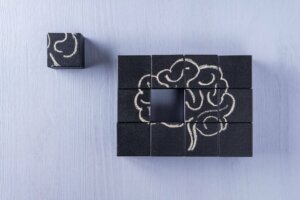Cognitive Rehabilitation: What Does it Consist Of?


Escrito y verificado por la psicóloga Leticia Aguilar Iborra
Cognitive rehabilitation is a new field. It refers to the methods used to compensate or improve the cognitive deficits that occur as a result of some alterations produced by brain injuries or diseases that prevent optimal cognitive functioning.
In this sense, cognitive rehabilitation doesn’t only offer improvements in the brain and, therefore, in performance. It also allows for improvements in the social, family, personal and school areas. The importance of cognitive rehabilitation is considerable, since, in many cases, an increase in the quality of life depends on it.
What is cognitive rehabilitation?

Cognitive rehabilitation is understood as the set of procedures and techniques whose primary objective is to obtain improvements both in the cognitive performance of the person and in other areas of interest of the individual (social, family and work).
The aim of this type of therapy is to provide a certain degree of autonomy to the patient and improve their quality of life.
There are several cognitive rehabilitation techniques, sometimes related. In some cases, in fact, the program embraces more than one modality, bringing together paths and strategies.
Stimulation mechanisms
- Recovery: Used when the loss of performance affects a specific area and is partial. Repetition exercises are usually offered to improve performance in real life. An example of application is memory deficits.
- Compensation: An attempt is made to stimulate the use of compensatory mechanisms, when the affected area can no longer be recovered. In this case, the goal is to enhance the skills that have been preserved.
- Replacement: The patient is taught to use a series of tools or strategies that help minimize the difficulties caused by the deficit. External supports are used such as calendar, photographs, clocks, alarm clocks etc.)
- Activation-Stimulation: Activation strategies are used to clear blocked areas through the use of psychotropic drugs, behavior modification, or repetition strategies in the face of a specific stimulus.
- Integration: Aims to improve mental activity in a global way. We try to eliminate interference in information processing by working holistically.
Other modalities
In addition to the previous points, cognitive rehabilitation also uses the following modalities:
- Surgery: The replacement of damaged brain tissue. It is applied in the treatment of degenerative diseases such as Parkinson’s disease or Huntington’s chorea.
- Psychopharmacology: This uses drugs that improve cognitive functions by correcting chemical imbalances. In some cases, it involves dietary re-education, since some diseases are related to malnutrition, such as late-stage Alzheimer’s disease.
- Improvement of other important areas of the person’s life: Lifestyle is very important. It’s necessary to direct the patient to good habits and to a correct management of emotional and social health.
Who is it for?

The users who can benefit from cognitive rehabilitation are large and diverse. However, it’s true that every person is different and, therefore, rehabilitation needs to be adapted to specific needs.
In general, the benefits that are obtained with cognitive rehabilitation are improvements in memory, attention, level of processing and speed of reaction to stimuli, problem-solving, etc. Therefore, cognitive stimulation is usually aimed at:
- People with acquired or congenital brain damage.
- Neurodegenerative diseases: Alzheimer’s disease, Parkinson’s disease, multiple sclerosis, Lewy body dementia, frontotemporal dementia, etc.
- Mental or mood disorders: chronic depression, bipolar disorder, etc.
- Neurological development disorders: attention deficit hyperactivity disorder (ADHD), autism, etc.
Before starting a cognitive rehabilitation: factors to consider
As we’ve said, cognitive rehabilitation must be individualized and adapted to the specific needs of the patient.
For example, people with acquired brain damage make up a very heterogeneous group. The origin of the injury itself can vary, from external factors (for example, a blow received on the head) to internal processes (brain hemorrhages, ischemias, etc.).
The level of awareness of the damage will also be taken into account, checking that the patient’s behavior is in line with the rehabilitation process.
An important role is played by family members. In this sense, it isn’t only the therapist’s job to provide inputs or exercises that can be applied to real life; the support of family members is essential if the new skills acquired are to be stabilized.
In fact, rehabilitation isn’t only focused on improving deficits, but must also produce changes in the social sphere, in order to improve the ability to adapt and the quality of life.
Specialized learning techniques
In general, most rehabilitation programs involve acquiring new information through cognitive stimulation exercises. The techniques that have been shown to be most effective in people with brain damage are:
- Direct learning techniques: these allow you to strengthen basic skills. Among the strategies used we find the subdivision of complex activities into simpler sub-activities, exercises that help to connect new data learned to previous experiences, the use of therapist feedback, etc.
- Error-free learning: This is a direct learning technique that has been shown to be effective in patients with severe memory deficits. It consists of offering the subject a correct answer until they can consolidate this new information. An example is the association of names to faces, the initiation of behavioral sequences, etc.
- Procedural learning: People with severe memory deficits benefit from this repetition-based approach, although it does take some time.
Cognitive rehabilitation: a complex but useful path
There’s a wide range of cognitive rehabilitation programs available, depending on the type of deficit. The journey can take some effort, but improvements can usually be achieved.
The functional benefits are evident, but the emotional, family and social sphere of the patient mustn’t be neglected.
The goal of this treatment, therefore, goes beyond the pathology and extends to the ability to interact with the real world.
Cognitive rehabilitation is a new field. It refers to the methods used to compensate or improve the cognitive deficits that occur as a result of some alterations produced by brain injuries or diseases that prevent optimal cognitive functioning.
In this sense, cognitive rehabilitation doesn’t only offer improvements in the brain and, therefore, in performance. It also allows for improvements in the social, family, personal and school areas. The importance of cognitive rehabilitation is considerable, since, in many cases, an increase in the quality of life depends on it.
What is cognitive rehabilitation?

Cognitive rehabilitation is understood as the set of procedures and techniques whose primary objective is to obtain improvements both in the cognitive performance of the person and in other areas of interest of the individual (social, family and work).
The aim of this type of therapy is to provide a certain degree of autonomy to the patient and improve their quality of life.
There are several cognitive rehabilitation techniques, sometimes related. In some cases, in fact, the program embraces more than one modality, bringing together paths and strategies.
Stimulation mechanisms
- Recovery: Used when the loss of performance affects a specific area and is partial. Repetition exercises are usually offered to improve performance in real life. An example of application is memory deficits.
- Compensation: An attempt is made to stimulate the use of compensatory mechanisms, when the affected area can no longer be recovered. In this case, the goal is to enhance the skills that have been preserved.
- Replacement: The patient is taught to use a series of tools or strategies that help minimize the difficulties caused by the deficit. External supports are used such as calendar, photographs, clocks, alarm clocks etc.)
- Activation-Stimulation: Activation strategies are used to clear blocked areas through the use of psychotropic drugs, behavior modification, or repetition strategies in the face of a specific stimulus.
- Integration: Aims to improve mental activity in a global way. We try to eliminate interference in information processing by working holistically.
Other modalities
In addition to the previous points, cognitive rehabilitation also uses the following modalities:
- Surgery: The replacement of damaged brain tissue. It is applied in the treatment of degenerative diseases such as Parkinson’s disease or Huntington’s chorea.
- Psychopharmacology: This uses drugs that improve cognitive functions by correcting chemical imbalances. In some cases, it involves dietary re-education, since some diseases are related to malnutrition, such as late-stage Alzheimer’s disease.
- Improvement of other important areas of the person’s life: Lifestyle is very important. It’s necessary to direct the patient to good habits and to a correct management of emotional and social health.
Who is it for?

The users who can benefit from cognitive rehabilitation are large and diverse. However, it’s true that every person is different and, therefore, rehabilitation needs to be adapted to specific needs.
In general, the benefits that are obtained with cognitive rehabilitation are improvements in memory, attention, level of processing and speed of reaction to stimuli, problem-solving, etc. Therefore, cognitive stimulation is usually aimed at:
- People with acquired or congenital brain damage.
- Neurodegenerative diseases: Alzheimer’s disease, Parkinson’s disease, multiple sclerosis, Lewy body dementia, frontotemporal dementia, etc.
- Mental or mood disorders: chronic depression, bipolar disorder, etc.
- Neurological development disorders: attention deficit hyperactivity disorder (ADHD), autism, etc.
Before starting a cognitive rehabilitation: factors to consider
As we’ve said, cognitive rehabilitation must be individualized and adapted to the specific needs of the patient.
For example, people with acquired brain damage make up a very heterogeneous group. The origin of the injury itself can vary, from external factors (for example, a blow received on the head) to internal processes (brain hemorrhages, ischemias, etc.).
The level of awareness of the damage will also be taken into account, checking that the patient’s behavior is in line with the rehabilitation process.
An important role is played by family members. In this sense, it isn’t only the therapist’s job to provide inputs or exercises that can be applied to real life; the support of family members is essential if the new skills acquired are to be stabilized.
In fact, rehabilitation isn’t only focused on improving deficits, but must also produce changes in the social sphere, in order to improve the ability to adapt and the quality of life.
Specialized learning techniques
In general, most rehabilitation programs involve acquiring new information through cognitive stimulation exercises. The techniques that have been shown to be most effective in people with brain damage are:
- Direct learning techniques: these allow you to strengthen basic skills. Among the strategies used we find the subdivision of complex activities into simpler sub-activities, exercises that help to connect new data learned to previous experiences, the use of therapist feedback, etc.
- Error-free learning: This is a direct learning technique that has been shown to be effective in patients with severe memory deficits. It consists of offering the subject a correct answer until they can consolidate this new information. An example is the association of names to faces, the initiation of behavioral sequences, etc.
- Procedural learning: People with severe memory deficits benefit from this repetition-based approach, although it does take some time.
Cognitive rehabilitation: a complex but useful path
There’s a wide range of cognitive rehabilitation programs available, depending on the type of deficit. The journey can take some effort, but improvements can usually be achieved.
The functional benefits are evident, but the emotional, family and social sphere of the patient mustn’t be neglected.
The goal of this treatment, therefore, goes beyond the pathology and extends to the ability to interact with the real world.
Ginarte-Arias, Y. (2002) Rehabilitación cognitiva: aspectos teóricos y metodológicos, Revista de Neurología 34(9), 870 – 876
Mateer, C.A. (2003). Introducción a la rehabilitación cognitiva, Avances en Psicología Clínica Latinoamericana, 21, 11 – 20.
Este texto se ofrece únicamente con propósitos informativos y no reemplaza la consulta con un profesional. Ante dudas, consulta a tu especialista.







